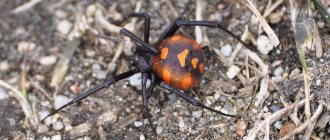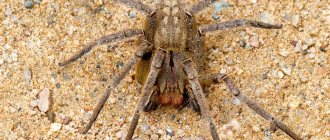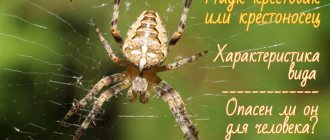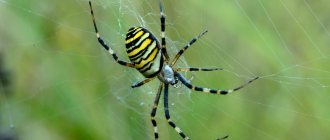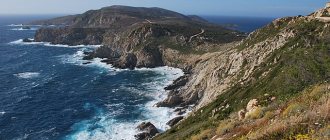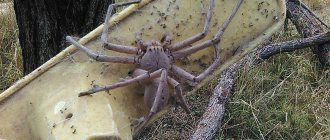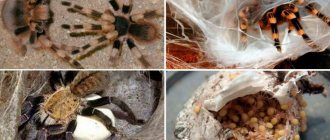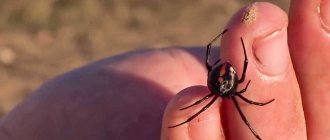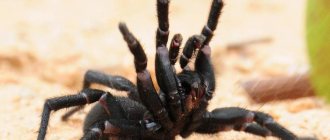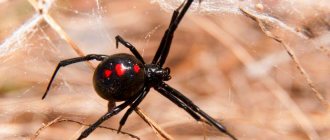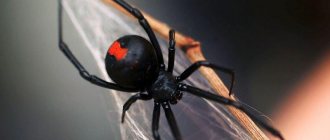Karakurt
Poisonous spiders of the Krasnodar Territory live in arid places, live in burrows underground, and do not build trapping nets. They behave without aggression towards humans, but they can bite in defense of their own life. Most attacks by karakurts occur due to negligence, when a person does not notice the predator in shoes, things, or in a clearing.
After a spider bite, pain, swelling, redness, and swelling appear. After 15 minutes, general health worsens - nausea, vomiting, abdominal pain, head pain, tremors, muscle spasms, difficulty breathing, increased blood pressure, increased heart rate. If medical assistance is not provided, cardiac arrest occurs or the person dies from suffocation.
The appearance of karakurt is memorable. The size of the female, together with the leg span, reaches 2 cm, the males are smaller. The most active young individuals. Legs, cephalothorax are black, red spots on the abdomen - 13 pieces. As they grow older, the color changes and becomes more uniform.
When to see a doctor
- a child or a person weakened by illness is bitten;
- the state of health of the bitten person deteriorates sharply;
- an allergic reaction began: severe pain and swelling, a rash around the bite site.
The most poisonous spiders in the world
Experienced tourists, when bitten by a tarantula while hiking, take a break for several hours, when the symptoms are most severe, and then continue the hike. But these are people who are already familiar with the spider and are ready for all sorts of consequences. It's better to go to the hospital.
There are millions of people in the world who suffer from arachnophobia, that is, the fear of arachnids. And their fears are not groundless: although most of them are completely or relatively safe for humans, among them there are those that threaten life. Spiders of Crimea do not graze their hind legs - in the fauna of the peninsula there are a number of poisonous representatives of eight-legged species, which we will talk about today.
South Russian tarantula
Dangerous spiders in Krasnodar live in dry places and build holes underground. The depth of the labyrinths of South Russian tarantulas reaches 40 cm. The entrance is protected by cobwebs. They feed on insects and their larvae. They hunt without leaving their own shelter.
The South Russian tarantula is the largest spider in the Krasnodar region. The body is covered with thick hairs, the legs are long and powerful. Colors are gray, brown, white, ash. It differs from other tarantulas by its dark head. The body size of the female, together with the leg span, reaches 35 cm.
The bite is poisonous, but not fatal. Painful sensations are present for several days, the skin recovers in 2 weeks. People prone to allergies experience a deterioration in their health - nausea, weakness, dizziness, headache.
It also has other names - yellow, heyracantium. Poisonous spiders of the Kuban and Krasnodar Territory live in arid places and build burrows in the ground. They hunt actively at night. They run quickly, attack a victim several times larger in size, and win.
The predator has a bright, memorable appearance. Legs, abdomen are yellow, cephalothorax is red, chelicerae are in the form of claws. Outwardly it looks more like a scorpion. The photo is presented below. The female is 1 cm in size, the males are 0.5 mm.
The spider is not aggressive towards humans, but it can bite in defense of its own life. At the site of the attack, an allergic reaction appears in the form of redness, swelling, and swelling. In young children and people prone to allergies, their health worsens. The condition returns to normal within a few days, the skin recovers within a week.
Spiders of the Krasnodar region
How to prevent a bite
For adults. In areas where poisonous spiders live, try to wear closed shoes and long trousers. Pay attention to the webs located closer to the ground. Do not camp or picnic in such areas. Just be careful. Remember that in Crimea, karakurts are found even on the beaches, in the coastal grass.
For children. Tell your child about karakurts. If you are walking in an area where it may live and you see webs on the ground, change your walking location to a safer one.
So he weaves a web among the stones
Summarize. Karakurts are dangerous, but not aggressive and attack, mostly due to our carelessness when we get too close to them. Observing the precautions described above will allow you to have a trouble-free vacation while hiking in the southern coastal countries.
Video of the fight between karakurt and scorpion
Wolf spider
The largest spiders of Kuban. A relative of the karakurt, but not so poisonous. The bite provokes a local allergic reaction and rarely causes deterioration in health. The color is ashen, brown. The body is covered with dense villi. Females reach sizes of 4 cm, males are half that size.
The wolf spider does not weave hunting nets; it hunts actively. The victims are insects, their larvae, amphibians, and small rodents. In search of prey, it explores new territories and creeps into human possessions. In the house, it doesn’t reveal its presence in any way; it hides in corners, behind furniture, cabinets with dishes, shoes, and things.
Black Eresus
The beautiful ladybug spider inhabits vast territories of Russia, found from the Rostov region to the Novosibirsk region. Having chosen a burrow once, black eresus rarely leave it. The instinct of reproduction pushes sexually mature males to take such a step, and caring mothers crawl out to warm the cocoons with future spiderlings in the sun. Eresus can bite only in case of self-defense. The consequences will be extremely unpleasant, but not fatal. At the moment of the bite, the person experiences severe pain, then numbness. You may experience sensitivity to pressure for a short period of time.
False black widow
Outwardly it differs from its deadly relative in that it is lighter in color. The characteristic hourglass pattern is not red, but pink. Belongs to the karakurt family. The size of females, together with the leg span, reaches 4 cm, males are half that size. They are nocturnal and weave strong fishing nets.
The false black widow will not bite unless touched. It sits calmly in the center of the homespun cloth, waiting for the victim. However, he often travels around the area, choosing hot spots. While traveling, it can crawl into a tourist’s belongings, vacationers’ shoes, house, or apartment.
Black widows are often kept as pets. Their coal-black shiny color and smooth movements attract the eye and make them admire the exotic creature. In artificially created conditions, a widow lives for about 10 years, in a natural environment she barely lives to be a year old.
The bite of the false black widow is poisonous and painful, but not fatal. In young children and people prone to allergies, a deterioration in well-being may follow, including swelling of the larynx and difficulty breathing. In this case, medical attention is required.
Popular types of spiders living in the Krasnodar region
Spiders of the Krasnodar region feed on insects and live among vegetation. Representatives have poisonous glands. Not all insects are dangerous to humans. However, you should not contact representatives. Even a non-fatal bite can result in allergic reactions and severe skin irritation. Spiders pose the greatest danger to animals and children. People with weakened immune systems or pregnant women are also at risk.
General signs
Mushroom places of the Krasnodar region and Adygea
As a rule, an ordinary spider has 6 pairs of limbs, but a person can notice only 4 pairs, since the organs of nutrition and touch are formed from the first 2 of them. The animal's body has 2 sections - the cephalothorax and abdomen, which are connected to each other by a thin bridge. If you carefully examine the spider, you will find that the cephalothorax also has a certain division into the chest and head parts using a thin groove. Limbs grow on the chest part, due to which the animal moves and weaves a web.
On the head of the spider there are:
- Chelicerae formed by the first pair of limbs.
- Pedipalps formed from the second pair of limbs. They serve for the spider both as an organ of touch and as a tool for catching and holding insects.
- Eyes.
- Oral apparatus.
The majority of species have 8 eyes, although the number of eyes depends on the habitat. So, spiders that live in caves where the sun's rays do not reach do not have eyes as such.
What insects live in Kuban
The Krasnodar region is rich in fauna. Many different insects live there. Some representatives are dangerous. The table shows the main individuals.
| Narynivnik | It's a bug that bites. The bite site begins to swell. A large blister appears. The insect has a rich color. This informs other fauna that it is toxic and potentially dangerous. You have to be careful. An animal or child who eats a beetle can die instantly. It will be practically impossible to prevent death. There are dark spots on the body. In appearance, the representative vaguely resembles a ladybug. |
| Scolopendra ringed | Large creature. The centipede has a poisonous jaw. The representative prefers dark and humid places. The insect is poisonous. The bite site swells. Lymph nodes swell. The body length is 15 cm. The poison affects the composition of the blood. Pain at the site of the bite persists for several days. The insect often settles in human dwellings. |
These are the main poisonous representatives of the Krasnodar region.
In the central part of the Russian Federation
The central part of Russia is characterized by pronounced seasonality. The climate is mostly humid and is not suitable for all arthropods. The following spiders are found here:
Silver spider
The only underwater representative of the world of spiders, the popular name is dropsy. Lives in bodies of water with standing water. The silverfish species are small spiders up to 15 mm in length, brown in color. Since dropsy is the only spider that is found on the surface of lakes and ponds, it cannot be confused with anyone else. If you disturb such a resident of a body of water, you may get a bite. Its venom is not dangerous to humans; the result of a bite is pain near the bitten area, which disappears in a few days.
Heiracanthium
Heiracanthium is the Latin name for the green spider in Russia. Popularly called sak or yellow-bag. The places where saka is distributed are Crimea, Krasnodar Territory, Rostov Region - it loves warm regions. Climate change is contributing to its emergence throughout the central part of the country.
The abdomen is yellow or beige, the cephalothorax is often orange, the green spider grows up to 15 mm. Its color appears green against the background of the leaves, hence the name. Sak builds web sacs and has the ability to jump. It has large chelicerae and poisonous claws; the yellowjacket bites painfully. The first sensations from a Heiracanthium sting are similar to those of a bee - a sharp, severe pain. The consequences can be different - from a long-healing wound to nausea and an allergic reaction. Depends on the age and health of the person.
Knitting spider
Popularly called the grandmother's spider. It often settles with a person, occupying corners of the apartment, cracks behind furniture, and weaves its “classic” web. It grows up to 1 cm, has a light brown color and an elongated abdomen on long legs. The knitter is absolutely harmless; when meeting a person, he prefers to pretend to be dead: fold his paws and sit motionless until the threat disappears.
What poisonous spiders can you find?
There are many poisonous spiders living in the Krasnodar Territory. Some representatives with their bite can lead to instant death.
Karakurt
Karakurt prefers arid areas. Lives in burrows underground. Does not behave aggressively towards people. In most cases, a karakurt attack occurs by accident when a person does not notice the insect in shoes or on things. In this case, the spider bites for protection.
After a bite, the skin swells. There is severe pain and redness. Within 10 minutes your overall health deteriorates. The following symptoms appear:
If first aid is not provided in a timely manner, cardiac arrest occurs.
The female reaches 2 cm. Males are smaller. Young spiders are more active. Gradually the color becomes more uniform. Young insects have dark spots on their bodies.
Source
Where is it found?
Karakurt can be found in the countries of the former Soviet Union:
- In Kazakhstan. Most often in desert areas.
- In the steppes of Kyrgyzstan.
- In Russia they live throughout the south of the country. Most often found in the Astrakhan and Rostov regions, in the Krasnodar Territory, and in the Southern Urals. In recent years, they began to come across in the Saratov, Volgograd and Novosibirsk regions, in Altai.
- In Crimea, almost throughout the entire peninsula.
- In Ukraine. In cities in the south that have access to the Black and Azov Seas, as well as in some cities in the east and south (Donetsk, Dnepropetrovsk, Zaporozhye and Mariupol).
- In Azerbaijan.
- In Kyrgyzstan.
Where else can you find this spider?
In countries located on the coasts of the Mediterranean, Adriatic and Caspian seas. Starting from southern Europe to the Near and Middle East, as well as North Africa.
Every year its habitat increases. Over the past few years, karakurt have been spotted in more northern regions of Russia and Eastern Europe, even in the Moscow region. Although, such a climate is completely unsuitable for it and with the onset of cold weather the spider itself and its cocoons die.
Crimean karakurt
The most dangerous representative of the poisonous inhabitants of Crimea, even more dangerous than the Crimean steppe viper. Inhabits the entire peninsula. Found en masse around Lake Koyashskoye.

